Retirement Planning: Smart Asset Allocation is crucial

In our earlier part, Retirement planning: Why should you get serious about it now, we had discussed that, unless you do proper financial planning from an early stage of your career, you are likely to run out of money and lose financial independence during your retirement years. I will re-emphasize the importance of financial planning because without it, improving lifestyle, longevity, inflation and taxes keep pushing your goal post further and further away from you. Unfortunately, in India, very little importance is given to financial planning.
A financial literacy survey conducted by Standard and Poor last December showed that nearly 76% of adult Indians fare poorly in financial literacy. Forget about comparing ourselves with advanced economies in financial literacy, we scored the lowest even among the five major emerging economies, the BRICS countries. While the state of our financial literacy is quite disappointing, simply being literate is not enough. We need to be educated.
What is the difference between literacy and education? The common understanding is that, literacy is the ability to read and write, while education is about getting degrees and diplomas. I have a different take on this. In my opinion, literacy is about knowing a concept while education is about understanding problems and solutions for our development and progress. In Advisorkhoj, our objective is to make our readers more educated, so that they can improve their own financial well being.
Coming back to retirement planning, while many Indians understand the importance of saving, most of us do not understand the difference between saving and investing. We will spend a minute or two, understanding the difference between the two, because it is important in ensuring the success towards your retirement goals. Saving, in very simple terms, is not spending a portion of your income and setting it aside for future use. Investing is about deploying your savings in assets to meet your goals. You may be wondering that, why are we talking about something so basic?
You have to understand that the most important difference between saving and investing is returns.
Why are returns so important in retirement planning
We work for about 40 years, earn money, save a portion of it, and then live on those savings for the next 30 years. To some readers, the complexity of the challenge is self evident, but for the benefit of the others, we will explain this with a very simplistic example. Let us suppose, you start working at the age of 20; you save 50% of your income every month; you take your cash savings and keep it in a secured place in your house. For the sake of simplicity let us assume that, your income remains the same throughout your working life and there is no inflation. How long will your savings last, after you retire at the age of 60? Your savings will last till the age of 80. Forget leaving money for your grandchildren, if you live till 90, then for the last 10 years of your life, you will have no money.
Let us now introduce some uncertainty. What if you stopped working at the age of 55, for whatever reason (e.g. job loss, health issues etc). Your savings will last only till the age of 72. For the last almost 20 years of your life, you will have no money. If your spouse is a few years younger than you, the situation for her is even more stressful. Our example is very simplistic, but the key message here is that, if your retired life is 70% of your working life (working life of 40 years and retired life of 30 years), then you need to save 70% of your income to fund your retirement. Most of you will agree with me that it is not possible. Hence, we can conclude that, saving “enough” will not solve your “retirement problem”.
So what is the solution then? It is really quite simple in concept. Just like you work hard in your career, make your savings money work hard too. In other words, invest your money to get higher returns.
Let us understand this, by going back to the example we discussed in first part, Retirement planning: Why should you get serious about it now. Rohan is fresh college graduate beginning his career. His take home salary is र 25,000 per month. He saves and invests 10% of his take home salary. His annual increment is 10%. Like many Indians, Rohan prefers risk free assured returns. How much return can he expect from risk free assured return investment? In the last 10 years, the average 10 year Government Bond yield has been around 8%. We can take this as a rough yield benchmark for risk free investment. How much will Rohan accumulate in his retirement nest egg?
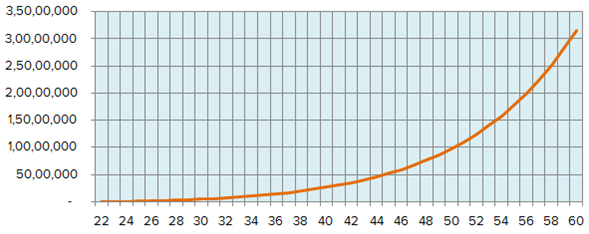
The chart above tells us that, Rohan will accumulate about र 3.20 crores in his retirement nest egg. How long will that money last him? When he is around 60, assuming that Rohan’s savings rate will still be 10%, his monthly expenses can be as high as र 8.50 lacs. However, we had discussed in the last post that the 50s is usually the stage of life, when our salaries are at their highest, but our expenses are also at their highest. In addition to home loan servicing, this is also the stage of life, when we pay for our children’s higher education, their wedding etc.
Hopefully, by the time Rohan retires, he will be debt free and his children will be settled in their individual lives. In this example, we have assumed that, Rohan’s post retirement expenses will be only 50% of his average expenses in his 50s, which means that his estimated monthly expenses on an inflation adjusted basis will be around र 3.50 lacs. The charts below shows how long will Rohan’s retirement savings last, given the above assumptions.
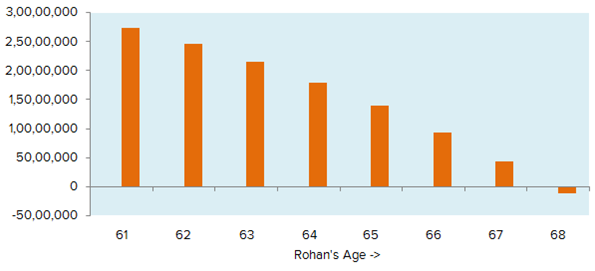
Rohan and his wife will run out of money by the age of 68. Please note that, for the sake of simplicity we assumed that risk free returns will be 8%. In reality, we need to factor in the effect of taxes. Most fixed income schemes are fully taxable, as per the income tax rate of the investor. Therefore, once we factor in taxation, Rohan’s retirement nest egg lasts for an even shorter period of time. While risk free assured return investments give Rohan peace of mind for the time being, it robs him of financial independence just a few years into his retired life.
When you are working, you can afford to take risks even though it can be a little stressful at times. However, running out of money during retirement years is emotionally much more stressful. Risk and return linkage is a fundamental law of Finance. It is not possible to get higher returns without taking more risks. I have met a number of investors who want 12 – 15% risk free assured returns. There is nothing stopping us from expecting anything in life. But there is a difference between expectations and reality. Over the past decades, investors have been taken for a ride by unscrupulous operators who assured high risk free returns. Let me tell you, it is not possible to get anything more than average Government Bond yield in risk free investments. In this example we have seen that, Rohan will not be able to meet his retirement goals by investing in risk free assured returns schemes.
Let us now explore a scenario where Rohan gets 12% return on his investment. The chart below shows, how much retirement corpus Rohan will be able to accumulate.
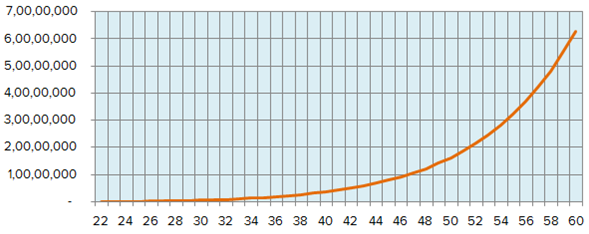
You can see in the chart above that, Rohan will be able to accumulate र 6.30 Crores if he gets 12% return on his retirement savings investments. How long will his retirement nest egg last?
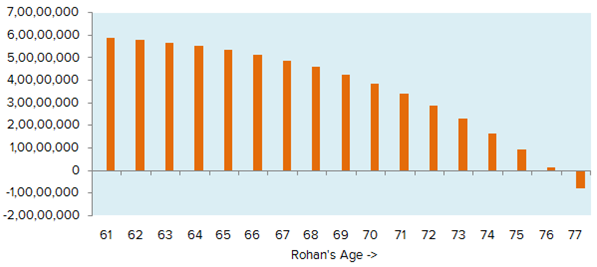
You can see that, his retirement corpus lasts for considerably longer till the age of 77, but still not long enough. How can he make it last longer? The logical answer is that he can make it last longer, either through higher savings or higher returns. We discussed in the first part, saving more is easier said than done. Rohan has to look for higher returns. How can he get higher returns? The answer lies in Asset Allocation.
Importance of Asset Allocation
What is Asset Allocation? Asset Allocation is the percentage mix of different asset classes like debt, equity, real estate and gold in your total asset or investment portfolio. In its simplest form asset allocation often refers to the percentage split between debt and equity investment. In the Indian context, real estate and gold are also very important asset classes. Different asset classes have different risk return profiles. Asset allocation is the most important aspect of financial planning, since it plays a bigger role in meeting your financial goals than any other factor (please see our post Asset Allocation is much more important than fund selection).
Why is Equity the best asset class for long term investments
If you are regular follower of our blog, you would have read time and again that, equity as an asset class, gives superior long term returns compared to other asset classes. An Economic Times report in January 2015, analyzing data over a 20 year time period, suggests the same. The chart below shows, the 20 year annualized post tax returns of Indian equity versus bank fixed deposit, gold and real estate.
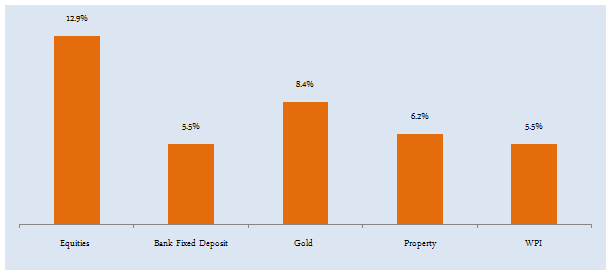
Source: Economic Times (January 2015). All returns are annualized, post tax
From the chart above, it is clear that, equity, on a post tax basis, is the best asset class in the long term, by a wide margin. By investing in good equity mutual funds, you can get higher than market returns, because good fund managers have the ability to create Alphas (read our blog post, How to select the best mutual fund: The importance of Alpha) and give a few extra percentage points of returns, over and above the market benchmark.
Let us now, go back to Rohan’s example and see how different asset allocation mixes impact his retirement planning. For the sake of simplicity, we will restrict ourselves only to fixed income and equity. In this analysis, we have assumed that long term post tax equity return will be 15% (assuming Rohan’s fund manager adds 2 – 3% Alpha) and post tax fixed income return will be 5.6%. The table below shows, how much corpus Rohan will be able to create given his savings rate, for different asset allocation mixes.
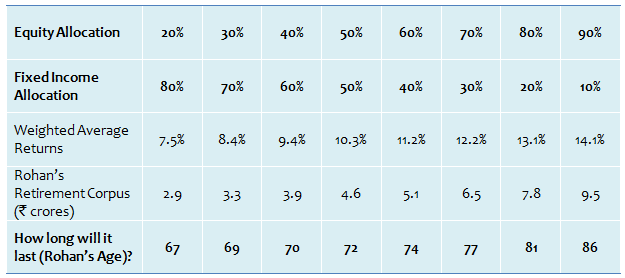
Conclusion
You can see from the table above, how important Asset Allocation is to retirement planning. I was discussing Rohan’s example, with a friend who is knowledgeable about financial planning and asset allocation. He referred me to a post that I myself had written sometime back and spoke about the “Rule of 100” (please refer to my post, Asset Allocation strategies for different age groups).
As per the Rule of 100, my friend suggested that, Rohan should be reducing his exposure to equities as he progresses through his career. The answer is, partly yes and partly no. Asset allocation rules like the Rule of 100 relates to the overall portfolio of an investor. Retirement planning investments is one part of the investment portfolio, but there will be other investments in your portfolio related to your other long term and short term goals. As such, as far as retirement planning is concerned, when you are young, you can even go for 100% equity asset allocation because you will not need the money in the short or even medium term, if you are saving for other financial goals as well. However, as you approach middle age, it will be prudent to gradually shift your asset mix from equity to fixed income, and by the time you retire, most of your investment (not entirely though) to fixed income.
Asset allocation not only ensures that you get better return it also provides your portfolio stability when required and when you approach retirement, protects your portfolio from capital losses. The importance of Asset Allocation in long term financial planning cannot be underestimated. Experienced financial planners can guide you through your asset allocation strategy. We have discussed various aspects of Asset Allocation from time to time in our blog and we will continue to do so in the future. If you pay attention to your asset allocation, you will be able to meet both your short term and long term financial goals.
Mutual Fund Investments are subject to market risk, read all scheme related documents carefully.
RECOMMENDED READS
Sundaram Asset Management Company is the investment manager to Sundaram Mutual Fund. Founded 1996, Sundaram Mutual is a fully owned subsidiary of one of India's oldest NBFCs - Sundaram Finance Limited.
Quick Links
- Interview - Mr. Dwijendra Srivastava - CIO - Fixed Income
- Interview - Mr. Sunil Subramaniam - CEO
- Sundaram Select Midcap Fund: Consistent outperformance makes it a big wealth creator
- Interview - Mr. Sunil Subramaniam - CEO
- Fund Manager Interview - Mr. Krishna Kumar - CIO - Equities
- Sundaram Rural India Fund: This thematic Mutual Fund aiming good long term returns
- Sundaram Equity Multiplier: Long term wealth creation potential
- Our Articles
- Our Website
- SIP one sheeter-Investor Education initiative
- Sundaram Asset Management Singapore
- Returns Calculator
- SEBI Investor Awareness Initiative
- Check your KYC Status
- KYC Forms & FAQs
- Recieve your PIN
- A note on NIGO
- FAQs on RGESS
- FAQs on Direct Plan
- Receive Updates
- Share your views
- Transmission Checklist
- Equity Application Form
- Fixed Income Application Form
- Transaction Slip
- Factsheet May - 2016
- MF Tax Reckoner 2015
Follow Sundaram MF
More About Sundaram MF
POST A QUERY




